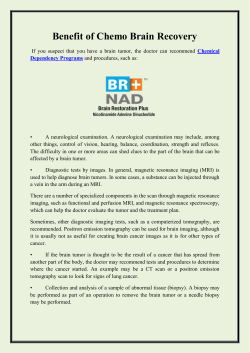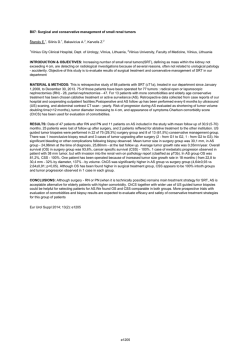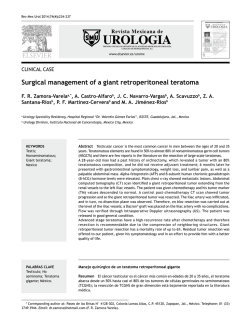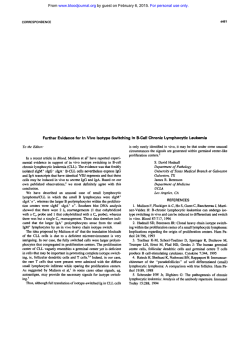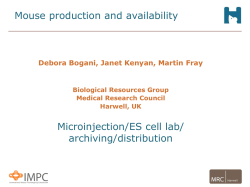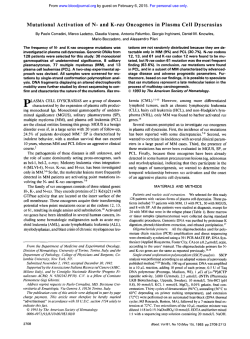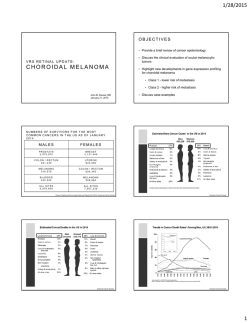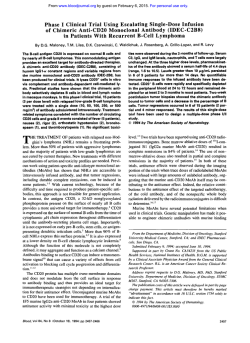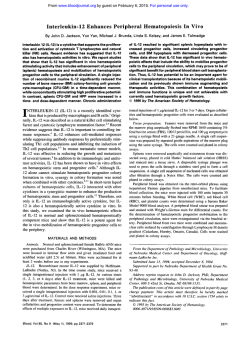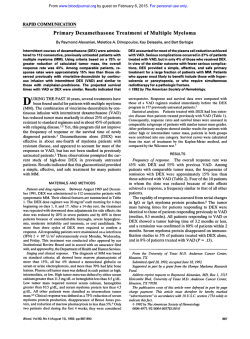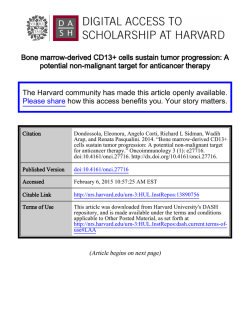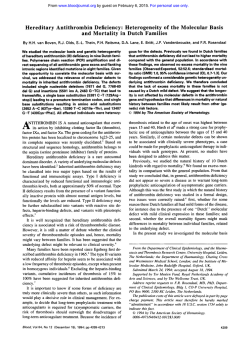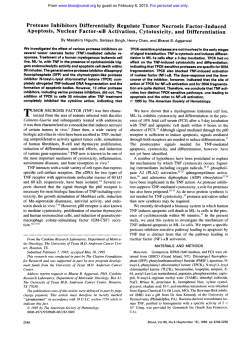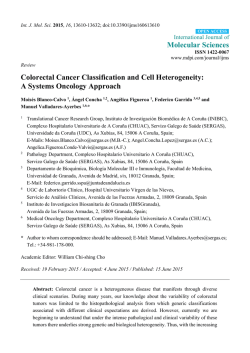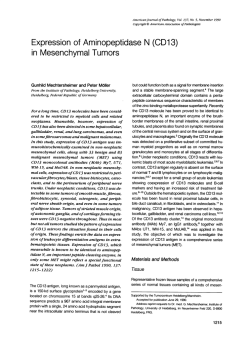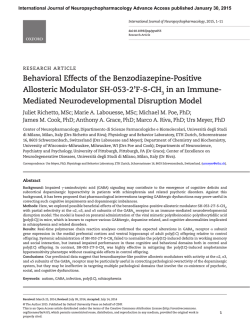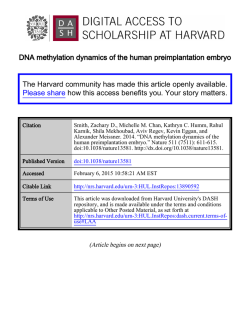
Alterations of the MMAC1/PTEN Gene in Lymphoid
From www.bloodjournal.org by guest on February 6, 2015. For personal use only. 4388 CORRESPONDENCE platelet count. However, taking into account the somewhat weaker thrombopoietic activity of Epo in humans11 as compared with mice, it remains to be seen whether Epo could be effective in correcting IL-12–induced thrombocytopenia in tumor patients. Because hematopoietic growth factors may occasionally stimulate the growth of neoplasms, including solid tumors,12,13 we decided to examine the influence of Epo application on the growth of MmB16 melanoma. Epo did not influence tumor growth when given alone and did not decrease the antitumor activity of IL-12 in this particular tumor model (Fig 1A and B). As the antitumor activity of IL-12 may by potentiated by administration of some of the chemotherapeutics,14 it might be anticipated that IL-12 together with Epo could be successfully included into some of the combined chemoimmunotherapy schedules. ACKNOWLEDGMENT Supported by Grant No. 6 P207 058 07 from the State Committee for Scientific Research (K.B.N), Poland. Tomasz Stokłosa is a recipient of the Foundation for Polish Science Award. Jakub Goła¸b Radosław Zagoz˙dz˙on Tomasz Stokłosa Witold Lasek Marek Jako´bisiak Department of Immunology Institute of Biostructure Medical University of Warsaw, Poland Zygmunt Pojda Department of Radiation Hematology WIHiE, Warsaw, Poland Eugeniusz Machaj Department of Experimental Hematology Maria Skłodowska-Curie Memorial Cancer Center Institute of Oncology, Warsaw, Poland REFERENCES 1. Nastala CL, Edington HD, McKinney TG, Tahara H, Nalesnik MA, Brunda MJ, Gately MK, Wolf SF, Schreiber RD, Storkus WJ, Lotze MT: Recombinant IL-12 administration induces tumor regression in association with IFN-g production. J Immunol 153:1697, 1994 2. Lasek W, Feleszko W, Goła¸b J, Stokłosa T, Marczak M, Da¸browska A, Malejczyk M, Jako´bisiak M: Antitumor effects of the combination immunotherapy with IL-12 and TNF-a in mice. Cancer Immunol Immunother 45:100, 1997 3. Jacobsen SEW, Veiby OP, Smeland EB: Cytotoxic lymphocyte maturation factor (Interleukin 12) is a synergistic growth factor for hematopoietic stem cells. J Exp Med 178:413, 1993 4. Eng VM, Car BD, Schnyder B, Lorenz M, Lugli S, Aguet M, Anderson TD, Ryffel B, Quesniaux VFJ: The stimulatory effects of interleukin (IL)-12 on hematopoiesis are antagonized by IL-12-induced interferon g in vivo. J Exp Med 181:1893, 1995 5. Atkins MB, Robertson MJ, Gordon M, Lotze MT, DeCoste M, DuBois JS, Ritz J, Sandler AB, Edington HD, Garzone PD, Mier JW, Canning CM, Battiato L, Tahara H, Sherman ML: Phase I evaluation of intravenous recombinant human interleukin 12 in patients with advanced malignancies. Clin Cancer Res 3:409, 1997 6. Coughlin CM, Wysocka M, Trinchieri G, Lee WMF: The effect of interleukin 12 desensitization on the antitumor effects of recombinant interleukin 12. Cancer Res 57:2460, 1997 7. Leonard JP, Sherman ML, Fisher GL, Buchanan LJ, Larsen G, Atkins MB, Sosman JA, Dutcher JP, Vogelzang NJ, Ryan JL: Effects of single-dose interleukin-12 exposure on interleukin-12–associated toxicity and interferon-g production. Blood 90:2541, 1997 8. Goła¸b J, Stokłosa T, Zagoz˙dz˙on R, Kaca A, Giermasz A, Pojda Z, Machaj E, Da¸browska A, Feleszko W, Lasek W, Iwan-Osiecka A, Jako´bisiak M: G-CSF prevents the suppression of bone marrow hematopoiesis induced by IL-12 and augments its antitumor activity in melanoma model in mice. Ann Oncol 9:63, 1998 9. Spivak JL: Recombinant human erythropoietin and the anemia of cancer. Blood 84:997, 1995 10. Harrison J, Kappas A, Levere RD, Lutton JD, Chertkov JL, Jiang S, Abraham NG: Additive effect of erythropoietin and heme on murine hematopoietic recovery after azidothymidine treatment. Blood 82:3574, 1993 11. Eschbach JW, Abdulhadi MH, Browne JK, Delano BG, Downing MR, Egrie JC, Evans RW, Friedman EA, Graber SE, Haley NR, Korbet S, Krantz SB, Lundin AP, Nissenson AR, Ogden DA, Paganini EP, Rader B, Rutsky EA, Stivelman J, Stone WJ, Teschan P, van Stone JC, van Wyck DB, Zuckerman K, Adamson JW: Recombinant human erythropoietin in anemic patients with end-stage renal disease. Results of a phase III multicenter clinical trial. Ann Intern Med 111:992, 1989 12. Segawa K, Ueno Y, Kataoka: In vivo tumor growth enhancement by granulocyte colony-stimulating factor. Jpn J Cancer Res 82:440, 1991 13. Feleszko W, Giermasz A, Goła¸b J, Lasek W, Kuc K, Szperl M, Jako´bisiak M: Granulocyte-macrophage colony-stimulating factor accelerates growth of Lewis lung carcinoma in mice. Cancer Lett 101:193, 1996 14. Zagoz˙dz˙on R, Stokłosa T, Goła¸b J, Giermasz A, Kaca A, Kultchitska LA, Lasek W, Jako´bisiak ML: Combination tumor therapy with interleukin-12, cisplatin, and tumor necrosis factor-a of experimental melanoma in mice. Anticancer Res 17:4493, 1997 15. Lasek W, Giermasz A, Kuc K, Wan´kowicz A, Goła¸b J, Zagoz˙dz˙on R, Stokłosa T, Jako´bisiak M: Potentiation of the antitumor effect of actinomycin D by tumor necrosis factor a in mice: Correlation between results of in vitro and in vivo studies. Int J Cancer 66:374, 1996 Alterations of the MMAC1/PTEN Gene in Lymphoid Malignancies To the Editor: The MMAC1/PTEN gene is localized on chromosome 10q23.3 and encodes a putative tumor suppressor with structural homologies to known phosphatases and cytoskeletal proteins.1,2 Functional studies have shown that MMAC1/PTEN is a dual-specificity protein phosphatase that dephosphorylates tyrosine, serine, and threonine.3,4 Germline mutations of MMAC1/PTEN have been implicated as the predisposing factor in Cowden disease,5 and loss of function mutations have been found in a variety of sporadic solid cancers.1,2,6 Previous observations of 10q abnormalities in lymphoproliferative diseases7,8 suggest that MMAC1/PTEN may possibly be involved in lymphomagenesis. We systematically studied 14 malignant and 4 benign lymphoid cell lines for deletions and mutations in all exons of the MMAC1/PTEN gene by combining polymerase chain reaction (PCR), denaturing gradient gel electrophoresis (DGGE) and direct sequence analysis.9 Overall, alterations of MMAC1/PTEN were shown in 2 of the malignant cell lines and in none of the benign cell lines. The T-cell acute lymphoblastic From www.bloodjournal.org by guest on February 6, 2015. For personal use only. CORRESPONDENCE leukemia cell line CCRF-CEM harbored homozygous deletion of a genomic region including exons 2 through 5. In the myeloma cell line HS-Sultan, we identified a C = T transition at the first base of codon 17, resulting in the substitution of glutamine with a premature termination signal. This cell line also showed loss of the wild-type allele. We next examined all exons of the MMAC1/PTEN gene by PCR/ DGGE analysis in 170 primary lymphoid malignancies (Fig 1). This approach led to the detection of point mutations in 2 (5%) of 39 diffuse large B-cell lymphomas. One of the samples harbored a G = C transversion at the third base of codon 342, which is predicted to cause the substitution of lysine with asparagine. This mutation affects the last base of exon 8, which is considered to be part of the donor-splice site consensus sequence required for correct splicing of pre-mRNA.10 Several examples of mutations at position 21 of donor-splice sites that cause skipping of the preceding exon have been reported.11 Whether the MMAC1/PTEN Lys342Asn mutation has functional consequences with respect to splicing remains to be investigated. Analysis of normal tissue from the patient showed only the normal sequence, documenting that the mutation occurred somatically. The second sample harbored a G = A transition at the second base of codon 10, causing substitution of serine with asparagine. This residue is conserved in auxilin and the hypothetical yeast PTPase, YNL128W.1 Semiquantitative DGGE analysis9 showed unequal distribution of mutant and wild-type sequences, suggesting that the mutation was present in only a subpopulation of cells. None of the mutations we identified have been reported to occur in normal tissues.12 Although MMAC1/PTEN alterations were found in only a minority of lymphoma cell lines and tumor samples, our results, together with the recent demonstration of mutations in leukemia cell lines,6 indicate that MMAC1/PTEN may be a target in the pathogenesis or progression of some forms of hematological malignancy. Fig 1. Detection and identification of MMAC1/PTEN mutations in primary lymphomas. (A) PCR/DGGE analysis of MMAC1/PTEN exon 1 in 10 tumor samples. (B) Direct sequence analysis of the sample displaying an aberrant band pattern in (A). The partial sequence ladder shows a G = A transition, resulting in the substitution of Ser10 with Asn10. 4389 ACKNOWLEDGMENT We are grateful to Dr H.E. Johnsen who generously provided cell lines, and to V. Ahrenkiel and L. Jensen for expert technical assistance. Supported by grants from the Danish Cancer Society, Kong Christian X’s Foundation, the Hasselbalch Foundation, and Søeborg Ohlsens Foundation. Kirsten Grønbæk Department of Tumor Cell Biology Institute of Cancer Biology Danish Cancer Society Copenhagen, Denmark Department of Pathology Herlev Hospital Copenhagen, Denmark Jesper Zeuthen Per Guldberg Department of Tumor Cell Biology Institute of Cancer Biology Danish Cancer Society Copenhagen, Denmark Elisabeth Ralfkiær Department of Pathology Herlev Hospital Copenhagen, Denmark Klaus Hou-Jensen Department of Pathology Rigshospitalet Copenhagen, Denmark REFERENCES 1. Steck PA, Pershouse MA, Jasser SA, Yung WK, Lin H, Ligon AH, Langford LA, Baumgard ML, Hattier T, Davis T, Frye C, Hu R, Swedlund B, Teng DH, Tavtigian SV: Identification of a candidate tumour suppressor gene, MMAC1, at chromosome 10q23.3 that is mutated in multiple advanced cancers. Nat Genet 15:356, 1997 2. Li J, Yen C, Liaw D, Podsypanina K, Bose S, Wang SI, Puc J, Miliaresis C, Rodgers L, McCombie R, Bigner SH, Giovanella BC, Ittmann M, Tycko B, Hibshoosh H, Wigler MH, Parsons R: PTEN, a putative protein tyrosine phosphatase gene mutated in human brain, breast, and prostate cancer. Science 275:1943, 1997 3. Li D-M, Sun H: TEP1, encoded by a candidate tumor suppressor locus, is a novel protein tyrosine phosphatase regulated by transforming growth factor b. Cancer Res 57:2124, 1997 4. Myers MP, Stolarov JP, Eng C, Li J, Wang SI, Wigler MH, Parsons R, Tonks NK: P-TEN, the tumor suppressor from human chromosome 10q23, is a dual-specificity phosphatase. Proc Natl Acad Sci USA 94:9052, 1997 5. Liaw D, Marsh DJ, Li J, Dahia PL, Wang SI, Zheng Z, Bose S, Call KM, Tsou HC, Peacocke M, Eng C, Parsons R: Germline mutations of the PTEN gene in Cowden disease, an inherited breast and thyroid cancer syndrome. Nat Genet 16:64, 1997 6. Teng DH, Hu R, Lin H, Davis T, Iliev D, Frye C, Swedlund B, Hansen KL, Vinson VL, Gumpper KL, Ellis L, El-Naggar A, Frazier M, Jasser S, Langford LA, Lee J, Mills GB, Pershouse MA, Pollack RE, Tornos C, Troncoso P, Yung WK, Fujii G, Berson A, Steck PA: MMAC1/PTEN mutations in primary tumor specimens and tumor cell lines. Cancer Res 57:5221, 1997 7. Speaks SL, Sanger WG, Masih AS, Harrington DS, Hess M, Armitage JO: Recurrent abnormalities of chromosome bands 10q23-25 in non- Hodgkin’s lymphoma. Genes Chromosomes Cancer 5:239, 1992 8. Takeuchi S, Bartram CR, Wada M, Reiter A, Hatta Y, Seriu T, Lee From www.bloodjournal.org by guest on February 6, 2015. For personal use only. 4390 CORRESPONDENCE E, Miller CW, Miyoshi I, Koeffler HP: Allelotype analysis of childhood acute lymphoblastic leukemia. Cancer Res 55:5377, 1995 9. Guldberg P, thor Straten P, Birck A, Ahrenkiel V, Kirkin AF, Zeuthen J: Disruption of the MMAC1/PTEN gene by deletion or mutation is a frequent event in malignant melanoma. Cancer Res 57:3660, 1997 10. Padgett RA, Grabowski PJ, Konarska MM, Seiler S, Sharp PA: Splicing of messenger RNA precursors. Annu Rev Biochem 55:1119, 1986 11. Krawczak M, Reiss J, Cooper DN: The mutational spectrum of single base-pair substitutions in mRNA splice junctions of human genes: Causes and consequences. Hum Genet 90:41, 1992 12. Tsou HC, Teng DH, Ping XL, Brancolini V, Davis T, Hu R, Xie XX, Gruener AC, Schrager CA, Christiano AM, Eng C, Steck P, Ott J, Tavtigian SV, Peacocke M: The role of MMAC1 mutations in earlyonset breast cancer: Causative in association with Cowden syndrome and excluded in BRCA1-negative cases. Am J Hum Genet 61:1036, 1997 A Response to AC133 Hematopoietic Stem Cell Antigen: Human Homologue of Mouse Kidney Prominin or Distinct Member of a Novel Protein Family? Three recently published works represent the first descriptions of a potential new family of 5-trans-membrane cell surface glycoproteins.1,2,3 The human AC133 molecule2,3 may indeed be the homologue of mouse prominin,1,4 and Drs Weigmann and colleagues have very carefully discussed the evidence for and against this relationship. We agree with the arguments put forward by these authors, and that further work is clearly needed to examine the possible localization of AC133 antigen to plasma membrane protrusions, and to assess the expression of prominin on murine hematopoietic stem cells. If prominin proves to be a marker of primitive murine stem cells, as AC133 is in humans, its value in studies of murine hematopoiesis would be considerable. To assist these studies, we have also isolated and characterized a prominin-like cDNA from mouse brain. This murine sequence differs slightly from the prominin sequence, as we have identified an additional block of nine amino acids within the N-terminal domain. These nine amino acids are strongly homologous to the corresponding human sequence (Fig 1). The cDNA isolated from mouse brain therefore predicts a protein of 867 amino acids, with a Fig 1. Alignment of human AC133, mouse AC133, and mouse prominin sequences, showing the position of a presumed nine– amino acid deletion in the mouse prominin sequence. molecular weight of 97.3 kD.5 The presence of murine AC133 transcript in a variety of mouse tissues was assessed by Northern analysis (Fig 2). A 4.4-k mRNA transcript was detectable in mouse embryo at 7 days, peaking at 11 days, and tapering off at days 15 and 17 while still being clearly detectable. In adult mouse tissue, the transcript is weakly detectable in brain, lung, skeletal muscle, and more intensely in kidney and testis. Molecular analysis of the three proteins from human, mouse and Caenorhabtidis elegans6 indicate that all three contain leucine zipper consensus sequences (on the first extracellular loop in the human and mouse, and on the second in C elegans). There are conserved cysteine residues in all three molecules appearing at the beginning of each small cytoplasmic loop. Although the mouse and human proteins exhibit strong conservation in all five predicted transmembrane sequences, the greatest degree of conservation with the C elegans sequence is within TM3, where 7 out of 22 amino acids are conserved in all three species. There are seven tyrosine residues within the C-terminal cytoplasmic tail in C elegans; however, none of them occur within a tyrosine phosphorylation consensus sequence. The cytoplasmic tails of the mouse and human proteins contain five tyrosine residues, the first of which is a tyrosine phosphorylation consensus sequence that is completely identical in both proteins. Another sequence7 in the Expressed Sequence Tag database, derived from murine embryo, has approximately 25% homology to the human and mouse AC133 antigen/ prominin sequences, indicating that these two molecules may indeed be the first described of a new family of cell surface receptors. The expression of such a gene or gene family on hematopoeitic human stem cells, mouse embryo, and adult tissues, and in a phylogenetically less evolved organism such as C elegans may indicate an important role for this five-transmembrane protein structure in development and/or cell signaling. In particular, the localization of the prominin molecule to cellular protrusions places this molecule in an optimal Fig 2. Northern analysis of murine AC133 antigen mRNA expression. Multiple tissue poly A1 Northern blots were purchased from Clontech (San Diego, CA) and probed with 32P murine AC133 antigen cDNA. (A) Expression of message is detectable in mouse embryo peaking at day 11, and then tapering off to still detectable levels at days 15 and 17. (B) In adult tissues, message is detectable in brain, lung, skeletal muscle, kidney, and testis. From www.bloodjournal.org by guest on February 6, 2015. For personal use only. 1998 91: 4388-4390 Alterations of the MMAC1/PTEN Gene in Lymphoid Malignancies Kirsten Grønbæk, Jesper Zeuthen, Per Guldberg, Elisabeth Ralfkiær and Klaus Hou-Jensen Updated information and services can be found at: http://www.bloodjournal.org/content/91/11/4388.full.html Articles on similar topics can be found in the following Blood collections Information about reproducing this article in parts or in its entirety may be found online at: http://www.bloodjournal.org/site/misc/rights.xhtml#repub_requests Information about ordering reprints may be found online at: http://www.bloodjournal.org/site/misc/rights.xhtml#reprints Information about subscriptions and ASH membership may be found online at: http://www.bloodjournal.org/site/subscriptions/index.xhtml Blood (print ISSN 0006-4971, online ISSN 1528-0020), is published weekly by the American Society of Hematology, 2021 L St, NW, Suite 900, Washington DC 20036. Copyright 2011 by The American Society of Hematology; all rights reserved.
© Copyright 2025
